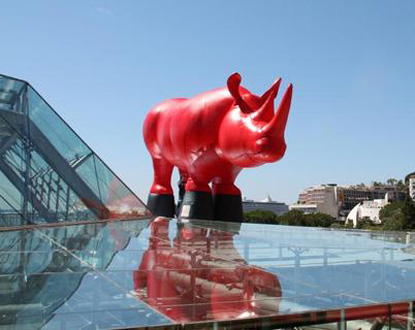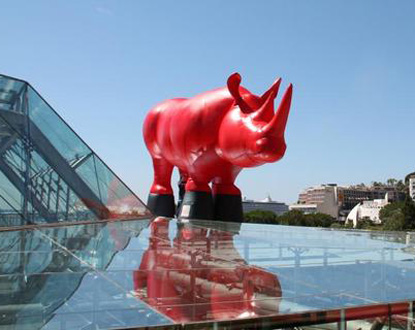 Too infrequently considered for what it is in itself and often reduced to the technical achievements it involves, monumentality nevertheless remains one of the responses – and not the least relevant – given by 20th and 21st century artists to the challenges posed by cinema and advertising.
Too infrequently considered for what it is in itself and often reduced to the technical achievements it involves, monumentality nevertheless remains one of the responses – and not the least relevant – given by 20th and 21st century artists to the challenges posed by cinema and advertising.
And while large formats have long served as a memory for History and supported values prescribed by religion and existing ideologies, the subversive movements that have profoundly altered representation codes for over a century have reversed the roles: today, monumentality can serve subversion and plunge the viewer into doubt by transforming the appearance of a subject through enlargement.
The EXTRA LARGE exhibition held at the Grimaldi Forum in Monaco until September 9, 2012, offers the visitor the chance to verify this through an encounter with the monumental works of the Centre Pompidou’s National Museum of Modern Art collection. This exceptional exhibition, as its name suggests, invites contemporary art enthusiasts to one of the smallest countries in the world to grasp the stakes of monumentality in pictorial practice…
The game of immersion is instantly set in motion, a game once initiated in different times and places by Monet’s Water Lilies. From the first exhibition spaces, the spectator is drawn in and absorbed by the gigantism of the works in front of which they pause and come into harmony with them, much like entering into communion with the cosmos when losing oneself in the contemplation of a grand landscape. Barely having crossed the threshold, the viewer enters a first room that resembles an improbable airlock linking our world to a universe of giants. There, they are instantly confronted with the vastness and density of Polombe, by Frank Stella, a canvas measuring nearly ten meters long. This work, adorned with motifs from the artist’s previous compositions, creates an illusion of the third dimension through a tangle of details swirling in every direction, challenging the staunch advocates of pictorial analysis. Barely exiting this particle accelerator, the visitor must confront the impressive Powers of Disorder by Roberto Matta and engage with the free electrons disturbing The Course of Things by Jean Dubuffet, under the unsettling gaze of Characters and Birds by Joan Miró. After this, how could they resist the call of the open sea and not drift away on the shimmering wave of In Lovely Blueness by Sam Francis? How might they not yield to the desire to merge into the foliage of The Large Valley XIV by Joan Mitchell to recover from these tumultuous beginnings and resume their journey to encounter further surprises?
For there are indeed surprises, repeatedly, waiting beyond the clearings leading to different moments of the exhibition to make an impression on our imaginations. We wish we could mention them all, as each is worth pausing to appreciate. From The Exploded Cabin to Daniel Buren and Xavier Veilhan’s phantom landscapes, where color no longer behaves as in The Exploded Cabin of Fattoria di Celle1 but always involves spatial fragmentation, to Group of 13 by Eva Aeppli, a poignant tribute to Amnesty International, via The Impossible Life by Christian Boltanski, The Wet Cloth Madonna II by Joseph Beuys, the Round Table by Chen Zhen, The Survivor by Yan Pei-Ming, the Praying Garden by Gilbert & George, and pausing a moment to Breathe the Shadow by Giuseppe Penone and slip between the sheets of N.Y., 06:00 A.M., the giant sardine can bed by Franck Scurti, the itinerary proposed by this exhibition is quite simply exceptional.
Despite Ben Vautier’s disapproval, who, without having seen it, makes it known online while hiding behind another that here “there is nothing monumental, except the rhinoceros on the roof,” while conceding that “there is quality but it’s a reheated quality for the specialists who have already seen everything at Beaubourg and elsewhere,” before concluding with a seemingly harsh formula: “I gave my invitation card to my daughter.” Good for her, but a pity you weren’t there, dear Ben, as you might have judged for yourself the undeniable quality of an event conceived with an openness to the uninitiated, not solely addressing the small circle of the highly enlightened or the regulars of all the prominent art venues. In this exhibition, excellently curated by Ariane Coulondre – formerly the brilliant and delightful curator of the Fernand Léger Museum in Biot, which would demonstrate that “value doesn’t wait for the number of years” – there is no battle of egos. Just a dialogue of Titans. Titans of art who, by their talent, bestow upon it and inscribe it with a dimension such that no minor narcissistic deity will ever be able to reach them…


